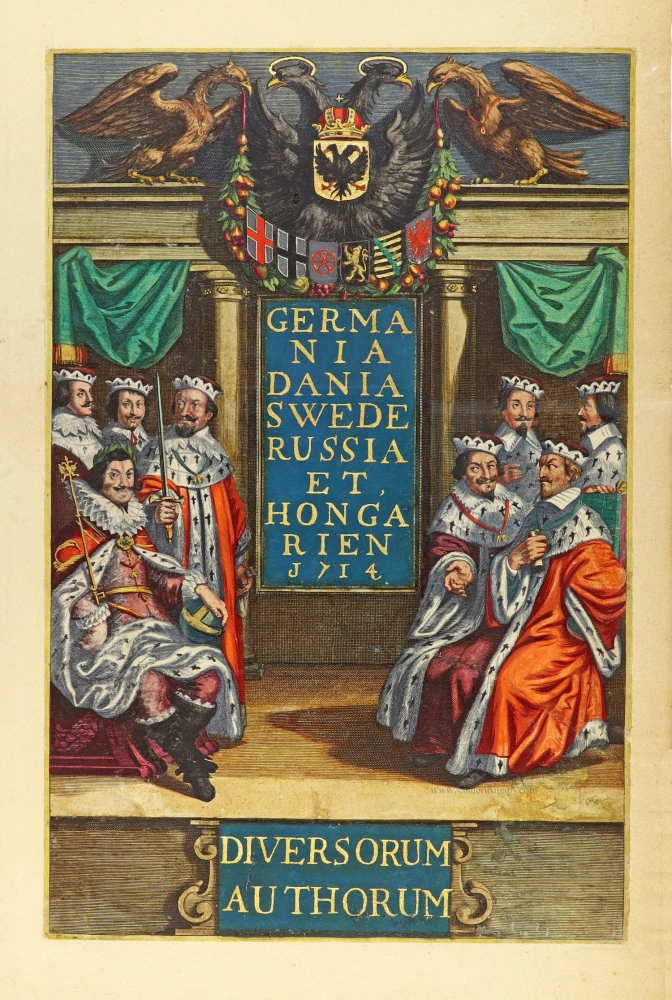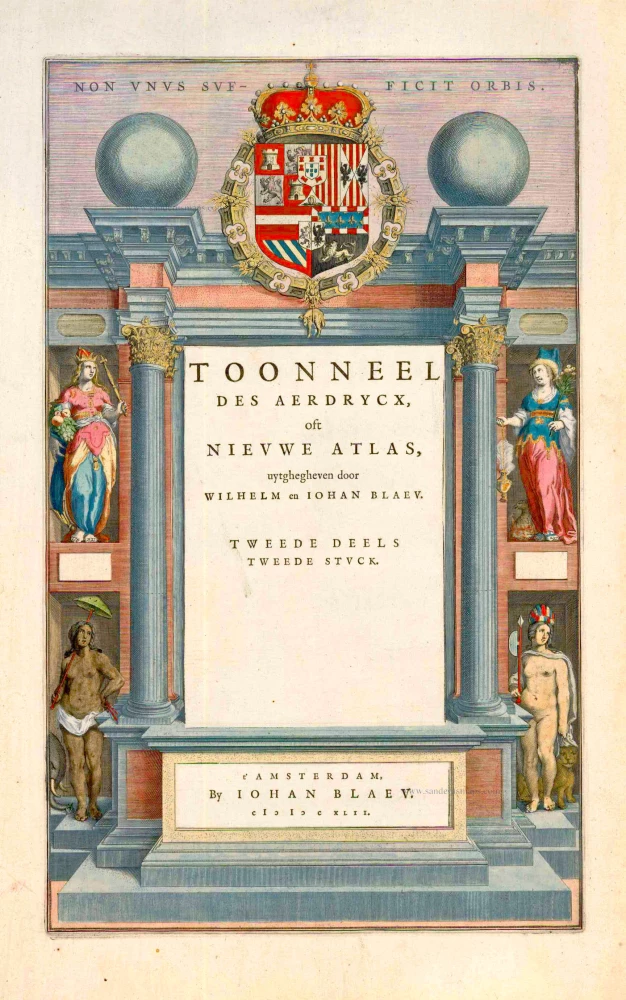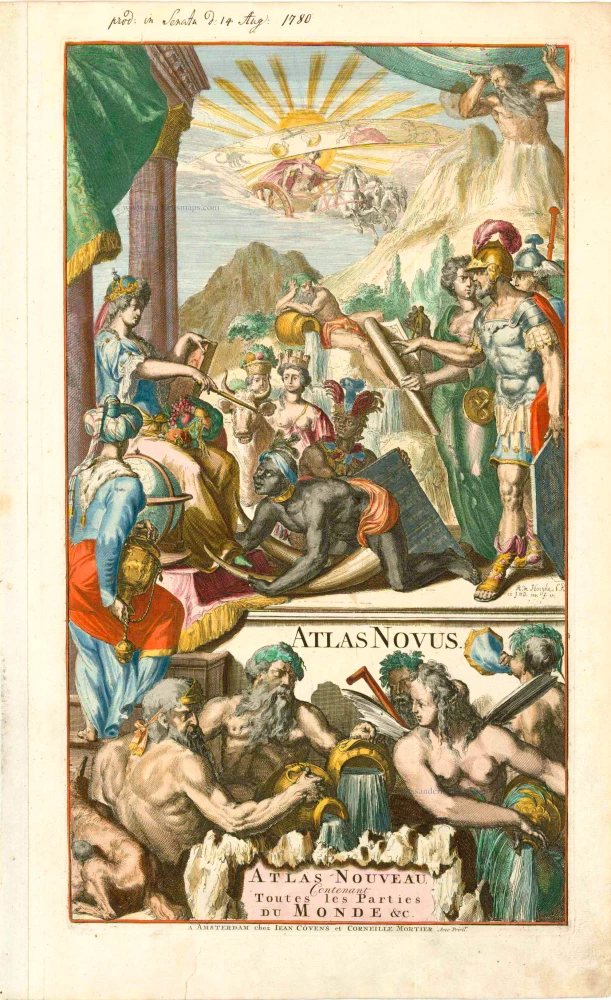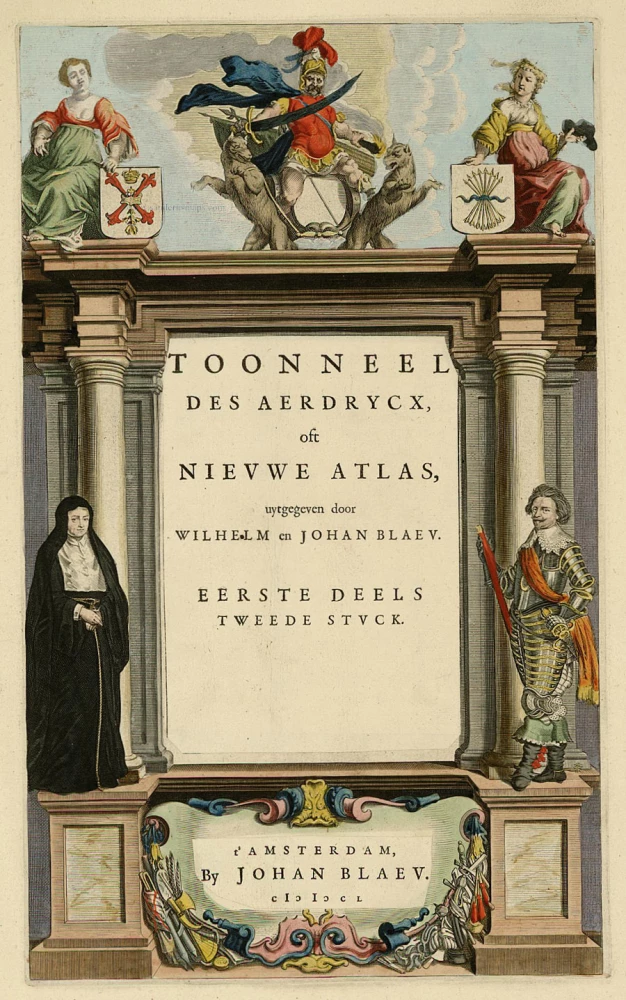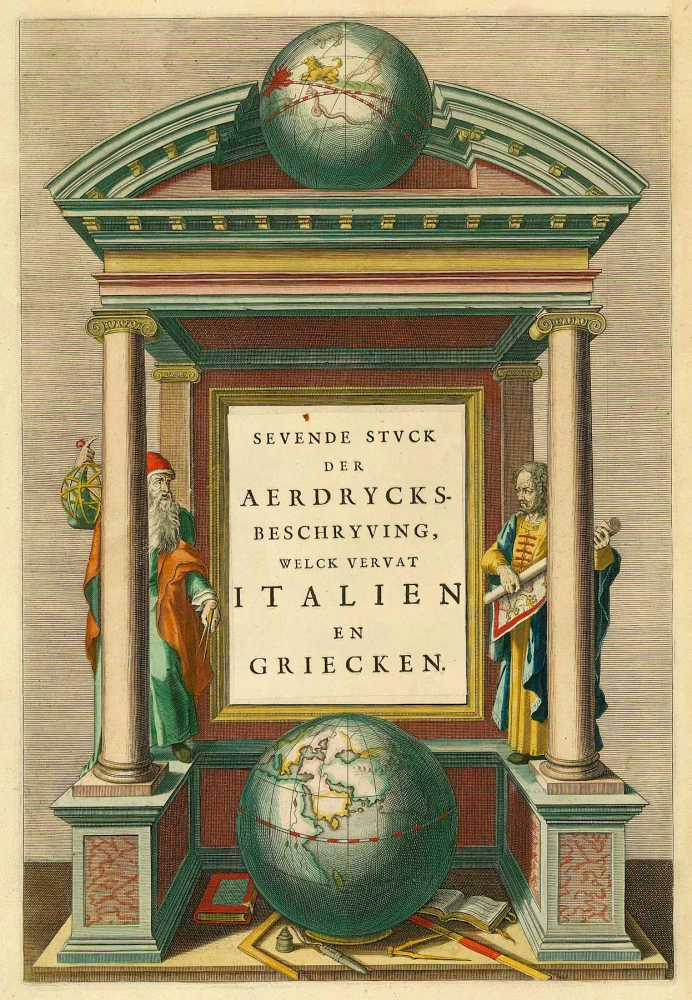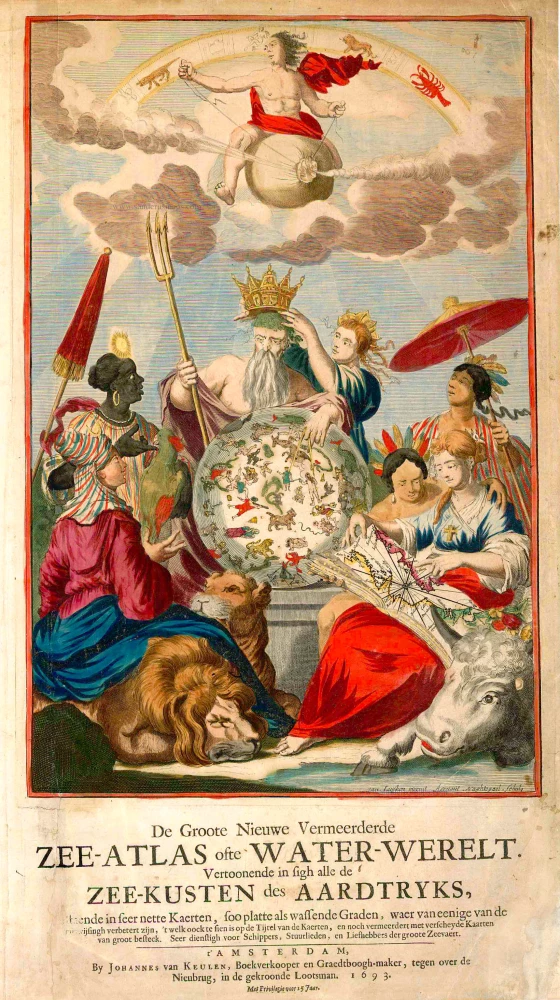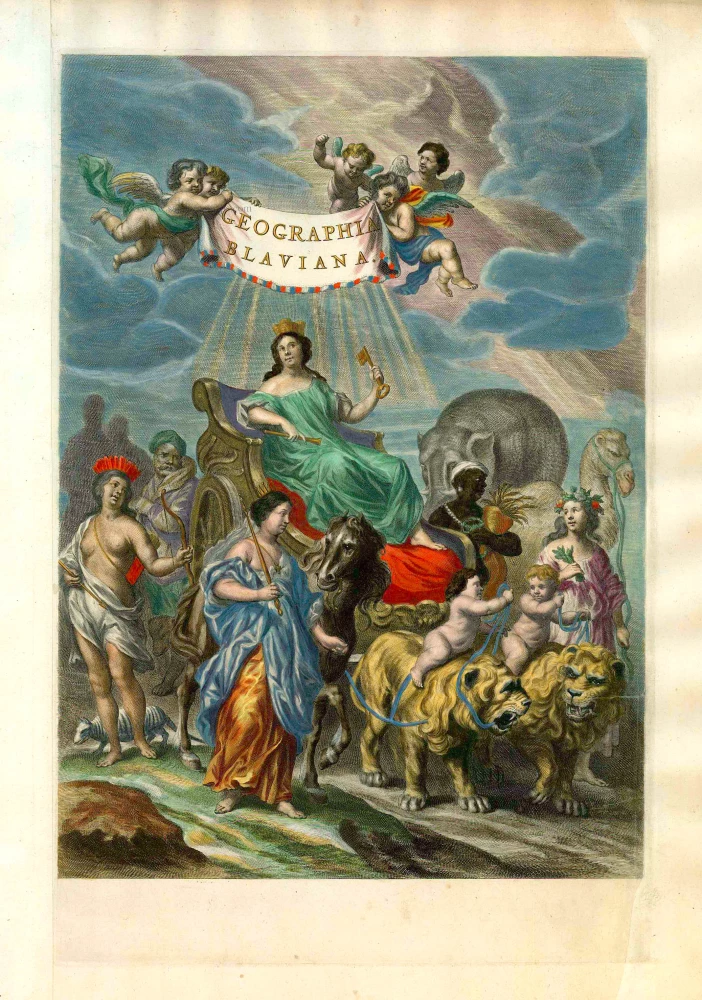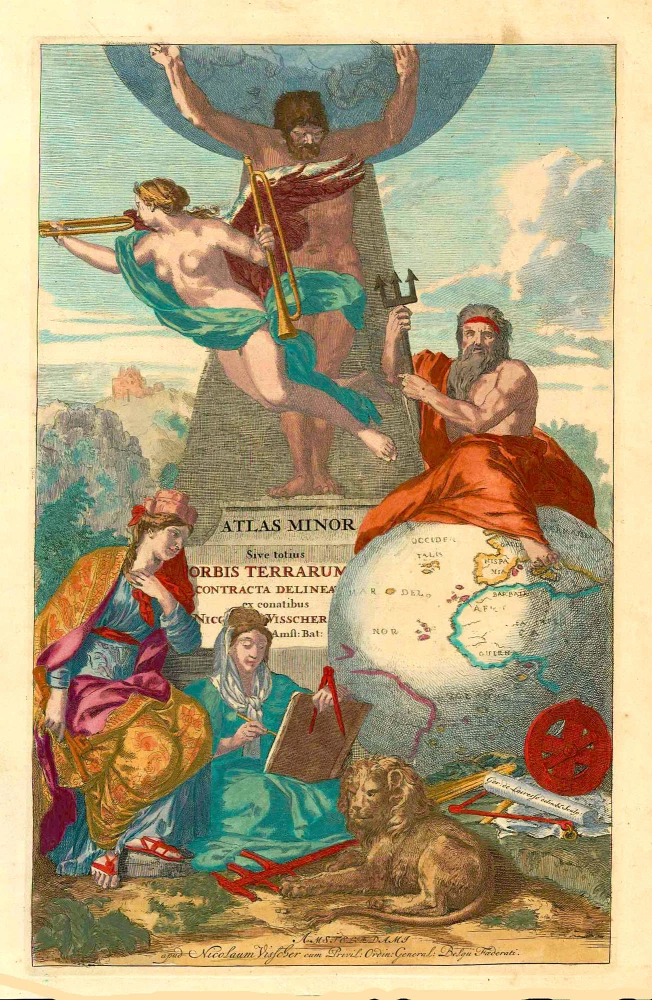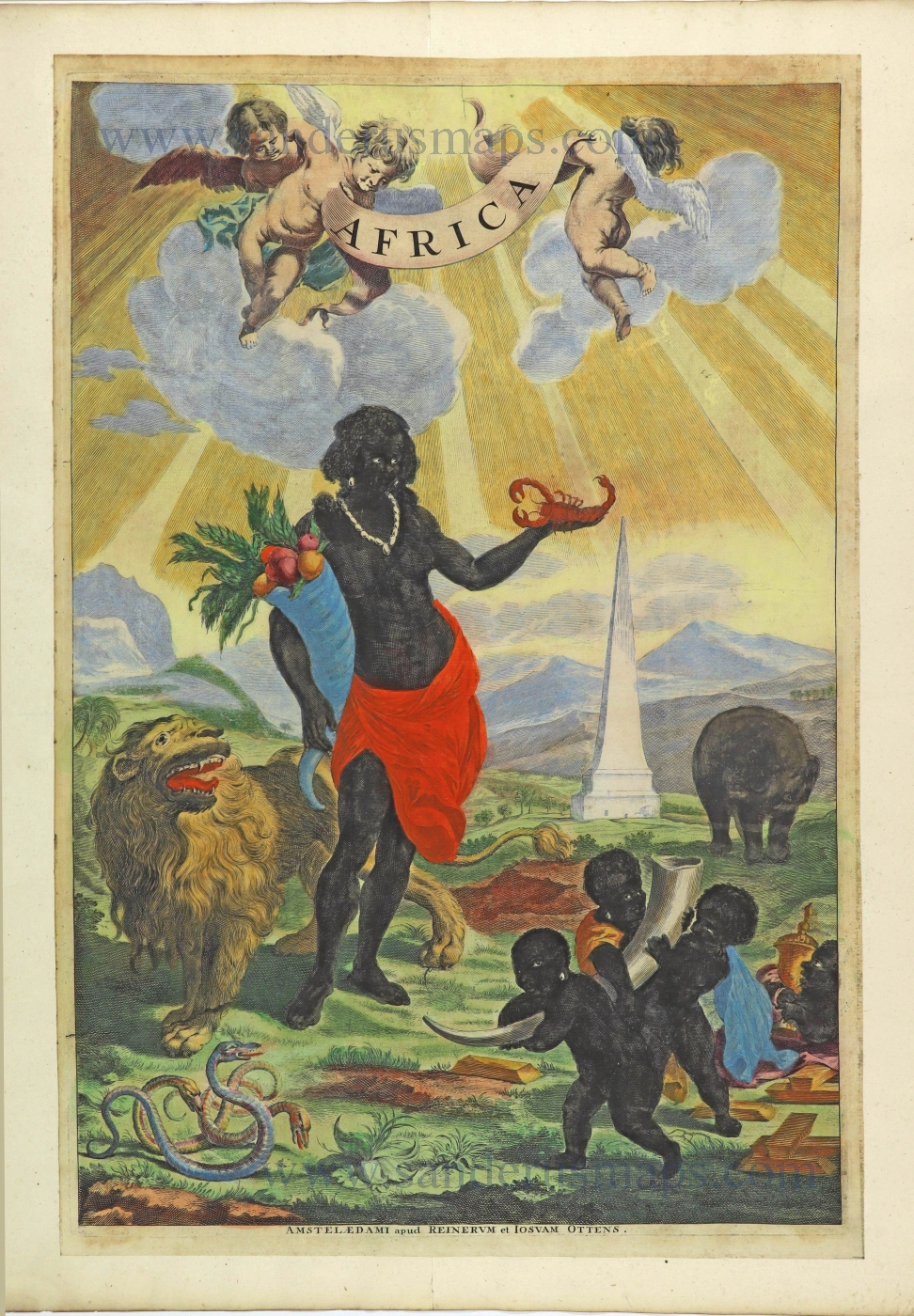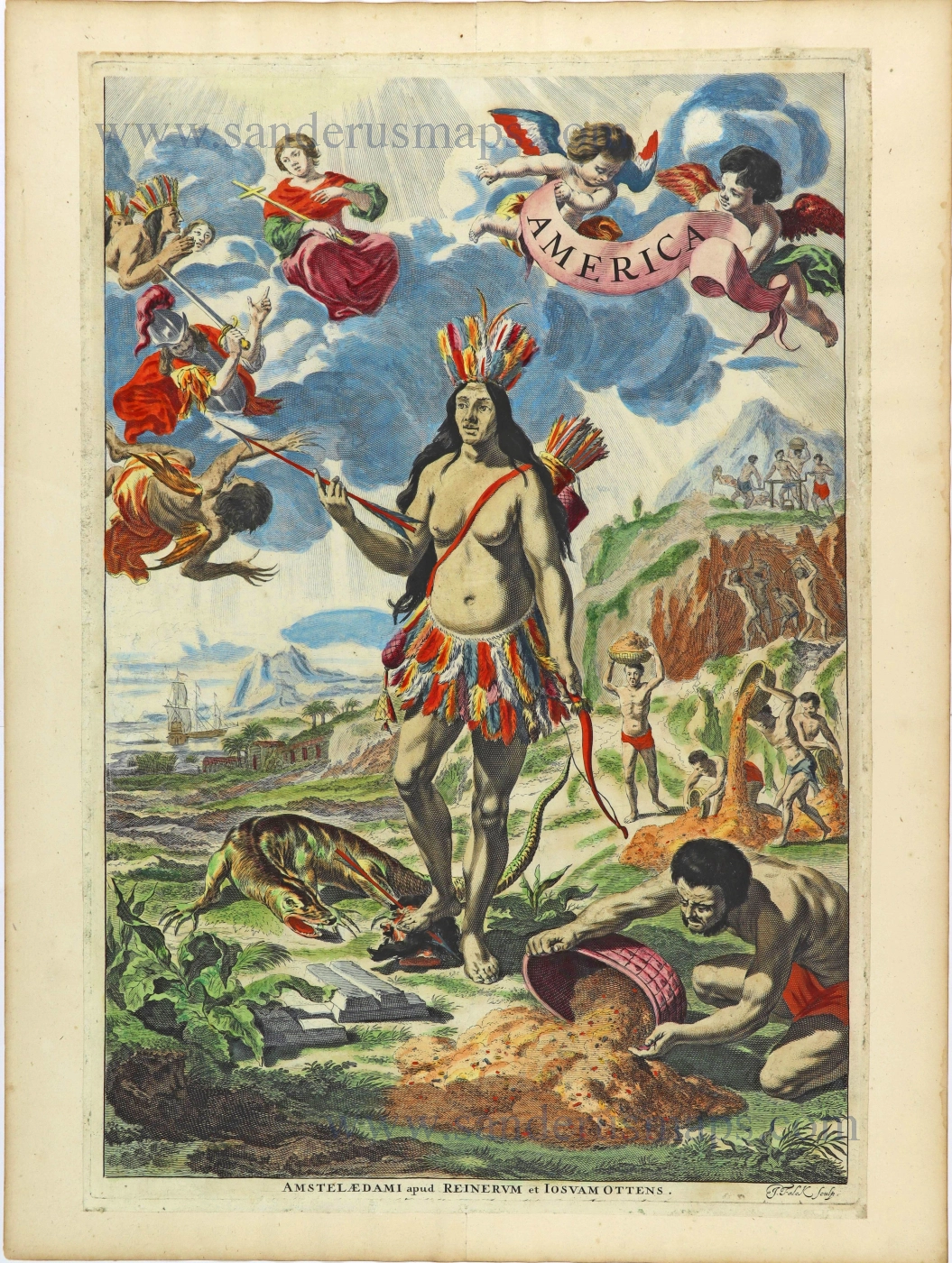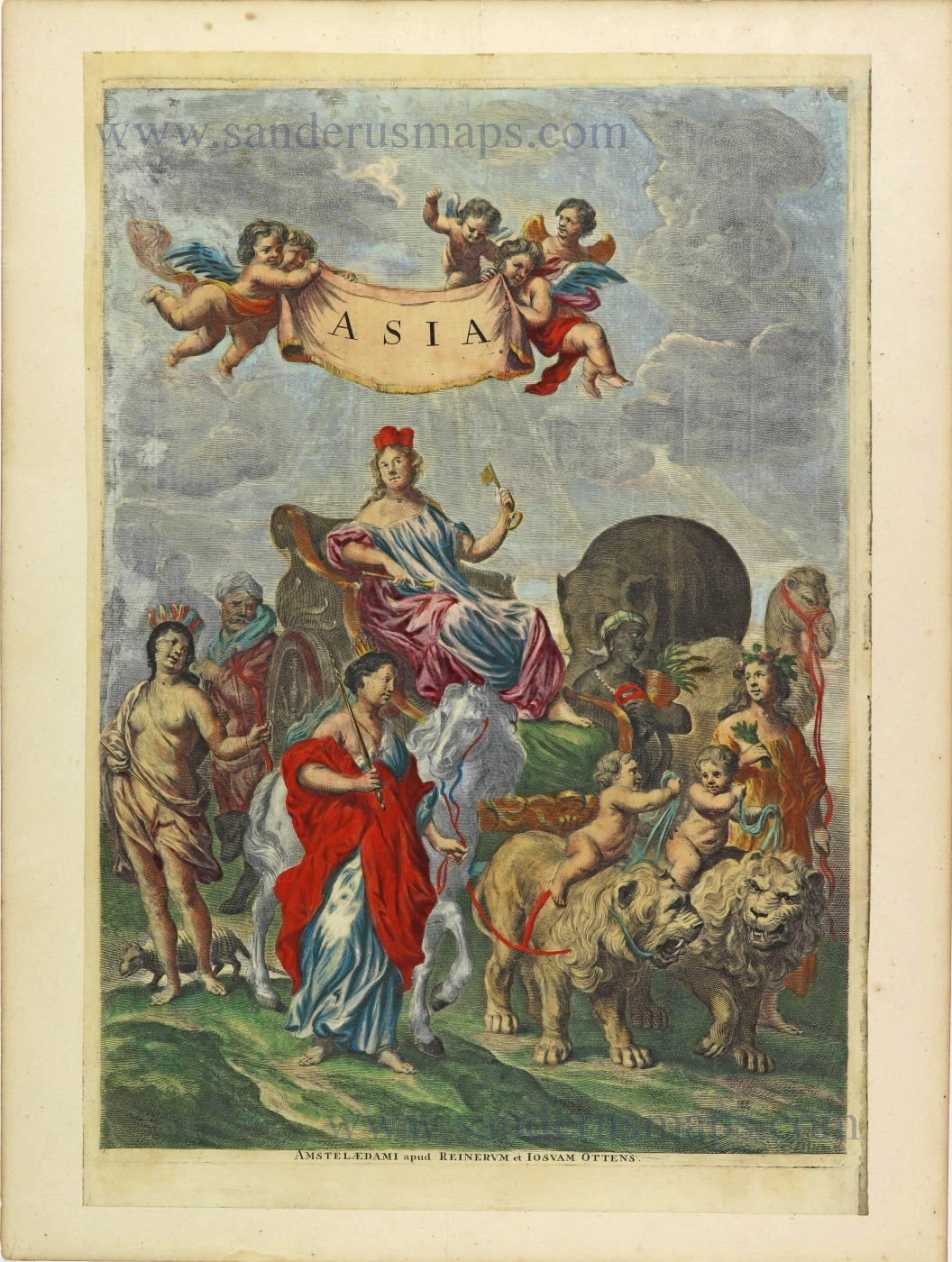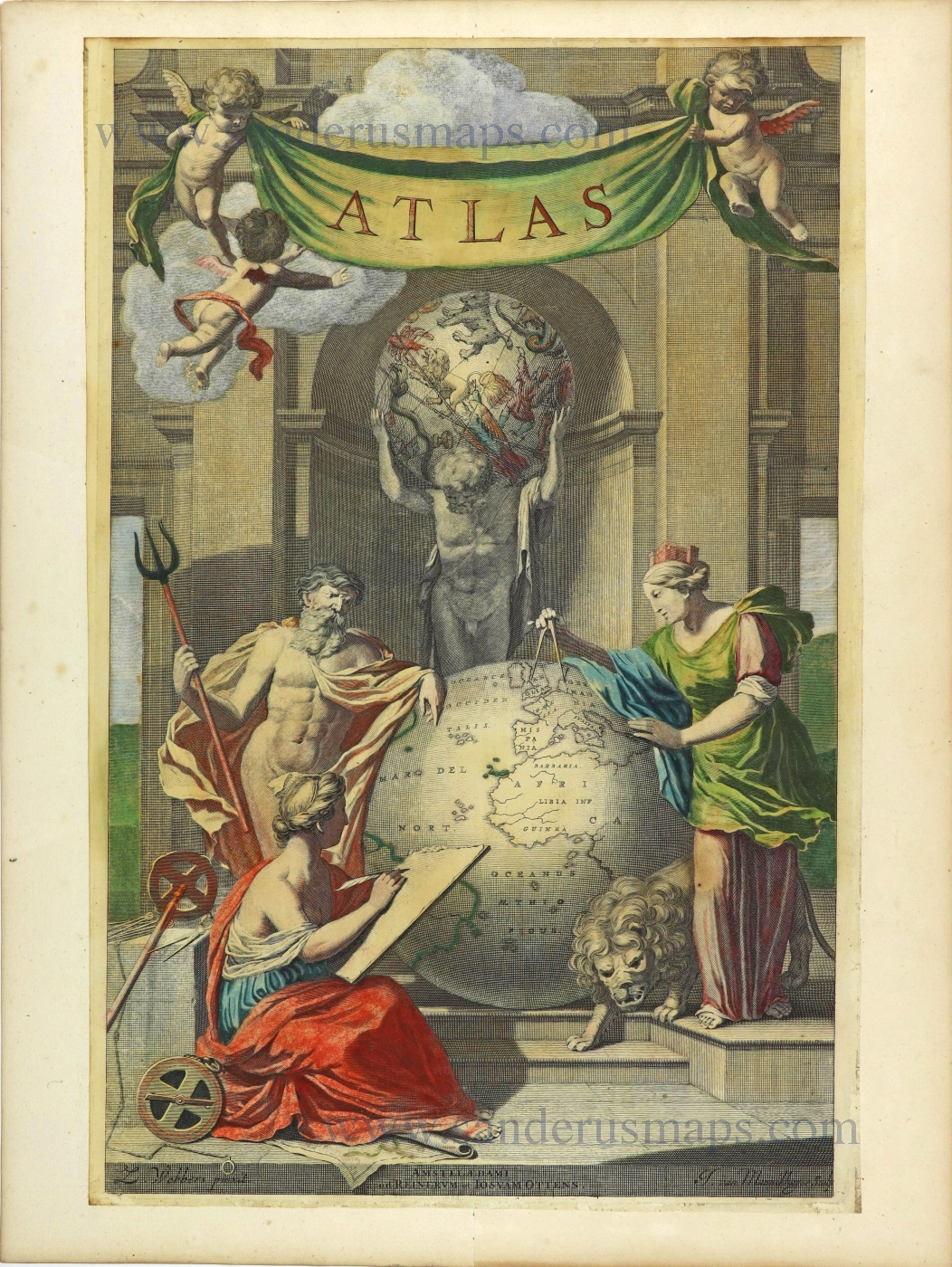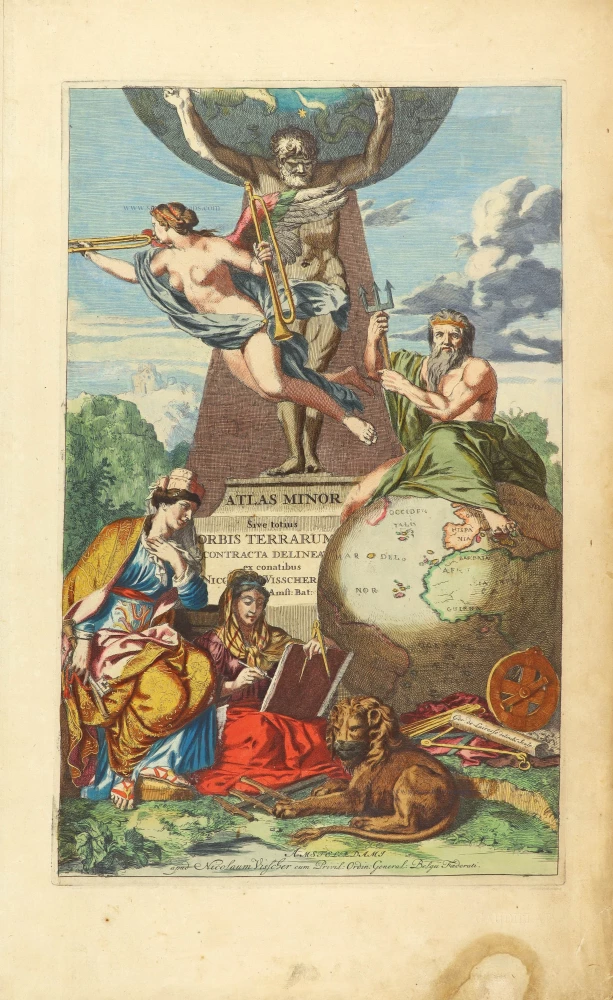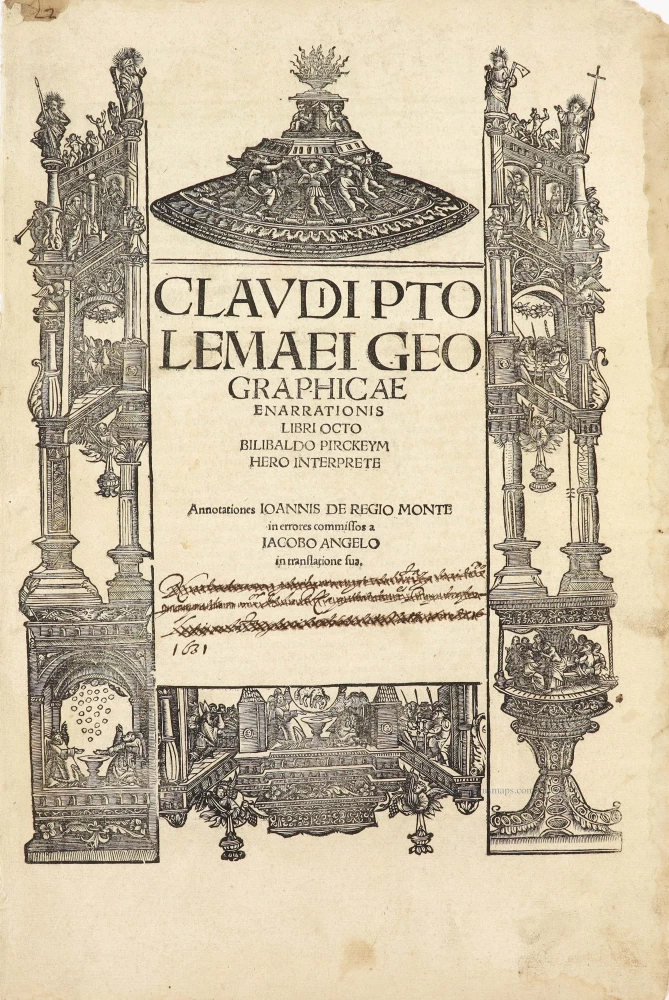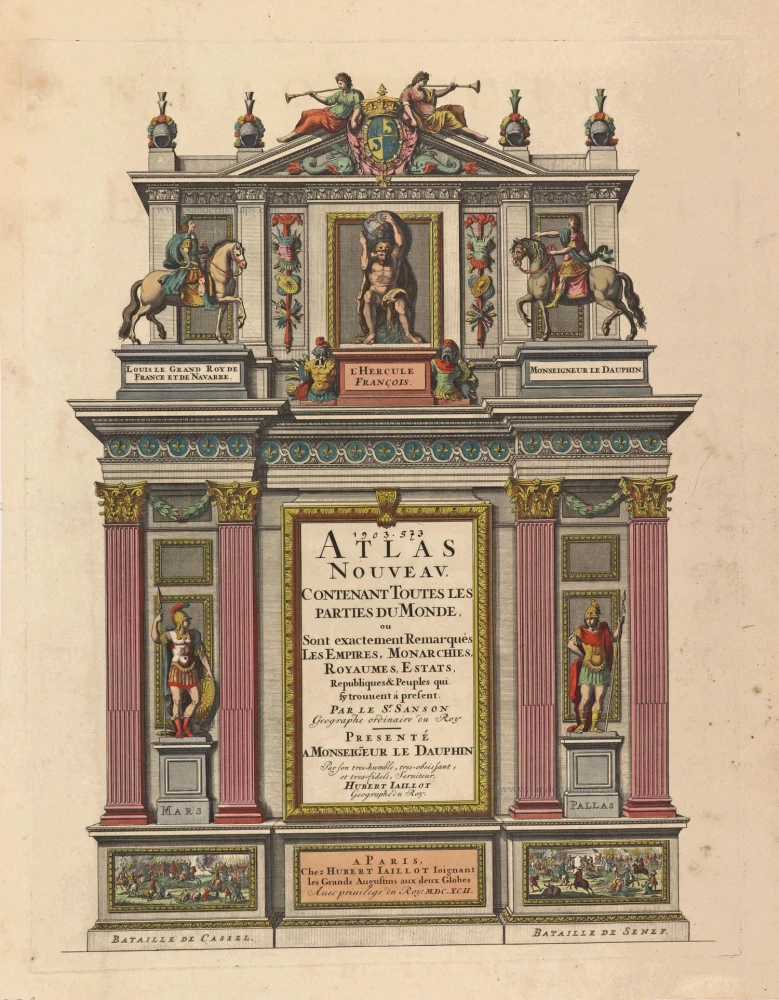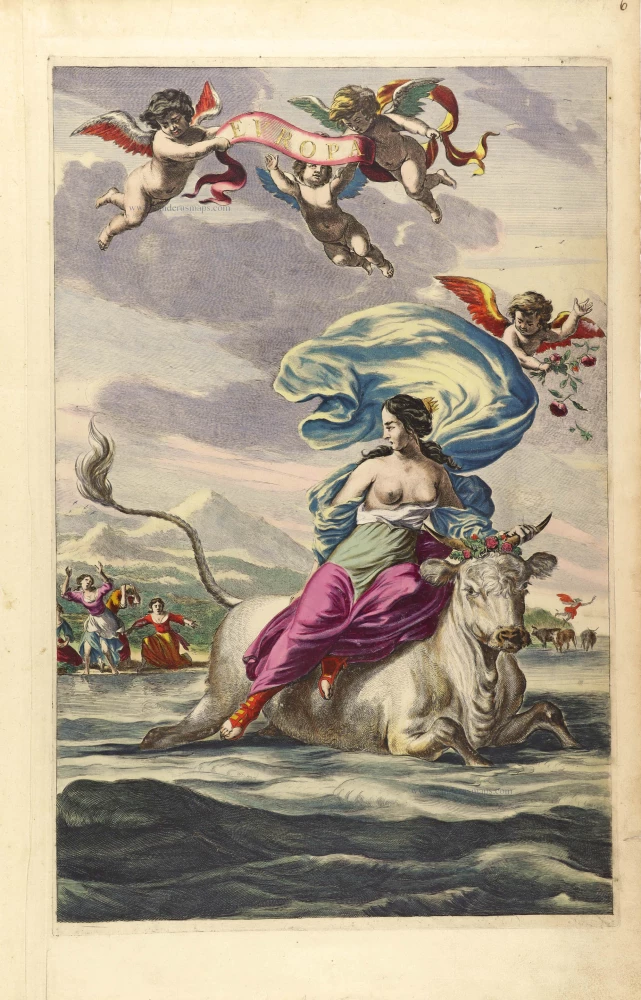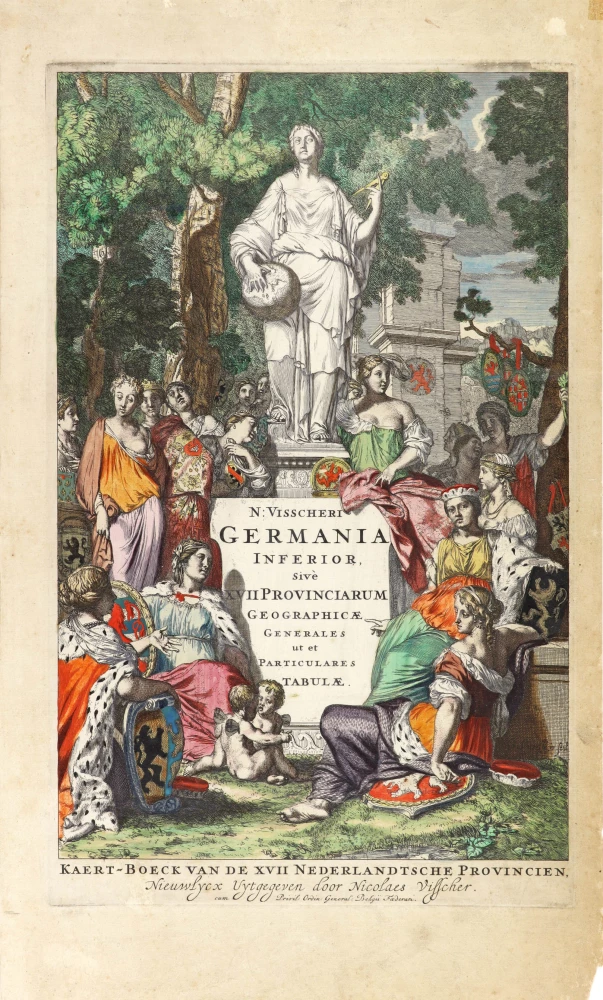Exceptional nice old colour. Heightened in gold.
Joannes Janssonius, title page 1714
Germany was under the nominal rule of the Holy Roman Emperor. His authority rested on the support of seven (later eight and then nine) Electors from the most important states or principalities. This title page shows eight such rulers in resplendent ermine cloaks on either side of the central title. The Holy Roman Emperor, King Ferdinand III, is seated on the left. He has a laurel wreath as a crown and holds an orb and sceptre as symbols of his majesty. Behind him are three Electors, whilst on the other side of the title are a further four; two seated and two standing. All have ermine caps and, like the Emperor, their distinctive facial characteristics suggest that their portraits are true to life.
At the top two eagles support, six armorial shields and within the embrace of a large Imperial double-headed eagle - each head with its golden halo - is the same double-headed eagle as on the Emperor's own escutchean surmounted by a crown.
The Janssonius Family
Joannes Janssonius (Arnhem, 1588-1664), son of the Arnhem publisher Jan Janssen, married Elisabeth Hondius, daughter of Jodocus Hondius, in Amsterdam in 1612. After his marriage, he settled down in this town as a bookseller and publisher of cartographic material. In 1618, he established himself in Amsterdam next door to Blaeu’s bookshop. He entered into serious competition with Willem Jansz. Blaeu when copying Blaeu’s Licht der Zeevaert after the expiration of the privilege in 1620. His activities concerned the publication of atlases, books, single maps, and an extensive book trade with branches in Frankfurt, Danzig, Stockholm, Copenhagen, Berlin, Koningsbergen, Geneva, and Lyon. In 1631, he began publishing atlases together with Henricus Hondius.
In the early 1640s, Henricus Hondius left the atlas publishing business to Janssonius. Competition with Joan Blaeu, Willem’s son and successor, in atlas production, prompted Janssonius to enlarge his Atlas Novus finally into a work of six volumes, into which a sea atlas and an atlas of the Old World were inserted. Other atlases published by Janssonius are Mercator’s Atlas Minor, Hornius’s historical atlas (1652), the townbooks in eight volumes (1657), Cellarius’s Atlas Coelestis and several sea atlases and pilot guides.
After the death of Joannes Janssonius, the shop and publishing firm were continued by the heirs under the direction of Johannes van Waesbergen (c. 1616-1681), son-in-law of Joannes Janssonius. Van Waesbergen added Janssonius's name to his own.
In 1676, Joannes Janssonius’s heirs sold by auction “all the remaining Atlases in Latin, French, High and Low German, as well as the Stedeboecken in Latin, in 8 volumes, bound and unbound, maps, plates belonging to the Atlas and Stedeboecken.” The copperplates from Janssonius’s atlases were afterwards sold to Schenk and Valck.
Germania Dania Swede Russia et Hongarien 1714. - Diversorum Authorum.
Item Number: 30095 Authenticity Guarantee
Category: Antique maps > Curiosities
Title page by Joannes Janssonius.
Manuscript title in gold: Germania Dania Swede Russia et Hongarien 1714. - Diversorum Authorum.
Date of the first edition: 1688.
Date of this page: 1714.
Copper engraving, printed on paper.
Image size: 430 x 295mm (16.93 x 11.61 inches).
Sheet size: 405 x 265mm (15.94 x 10.43 inches).
Verso: Blank.
Condition: Original coloured, heightened in gold, remargined, repairs in the bottom right corner.
Condition Rating: A
From: Composite Atlas.
Germany was under the nominal rule of the Holy Roman Emperor. His authority rested on the support of seven (later eight and then nine) Electors from the most important states or principalities. This title page shows eight such rulers in resplendent ermine cloaks on either side of the central title. The Holy Roman Emperor, King Ferdinand III, is seated on the left. He has a laurel wreath as a crown and holds an orb and sceptre as symbols of his majesty. Behind him are three Electors, whilst on the other side of the title are a further four; two seated and two standing. All have ermine caps and, like the Emperor, their distinctive facial characteristics suggest that their portraits are true to life.
At the top two eagles support, six armorial shields and within the embrace of a large Imperial double-headed eagle - each head with its golden halo - is the same double-headed eagle as on the Emperor's own escutchean surmounted by a crown.
The Janssonius Family
Joannes Janssonius (Arnhem, 1588-1664), son of the Arnhem publisher Jan Janssen, married Elisabeth Hondius, daughter of Jodocus Hondius, in Amsterdam in 1612. After his marriage, he settled down in this town as a bookseller and publisher of cartographic material. In 1618, he established himself in Amsterdam next door to Blaeu’s bookshop. He entered into serious competition with Willem Jansz. Blaeu when copying Blaeu’s Licht der Zeevaert after the expiration of the privilege in 1620. His activities concerned the publication of atlases, books, single maps, and an extensive book trade with branches in Frankfurt, Danzig, Stockholm, Copenhagen, Berlin, Koningsbergen, Geneva, and Lyon. In 1631, he began publishing atlases together with Henricus Hondius.
In the early 1640s, Henricus Hondius left the atlas publishing business to Janssonius. Competition with Joan Blaeu, Willem’s son and successor, in atlas production, prompted Janssonius to enlarge his Atlas Novus finally into a work of six volumes, into which a sea atlas and an atlas of the Old World were inserted. Other atlases published by Janssonius are Mercator’s Atlas Minor, Hornius’s historical atlas (1652), the townbooks in eight volumes (1657), Cellarius’s Atlas Coelestis and several sea atlases and pilot guides.
After the death of Joannes Janssonius, the shop and publishing firm were continued by the heirs under the direction of Johannes van Waesbergen (c. 1616-1681), son-in-law of Joannes Janssonius. Van Waesbergen added Janssonius's name to his own.
In 1676, Joannes Janssonius’s heirs sold by auction “all the remaining Atlases in Latin, French, High and Low German, as well as the Stedeboecken in Latin, in 8 volumes, bound and unbound, maps, plates belonging to the Atlas and Stedeboecken.” The copperplates from Janssonius’s atlases were afterwards sold to Schenk and Valck.

